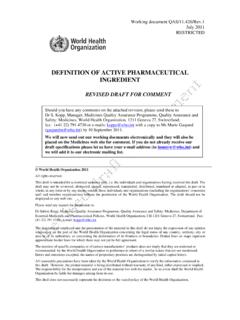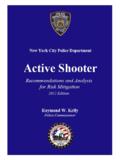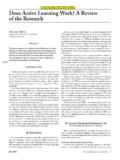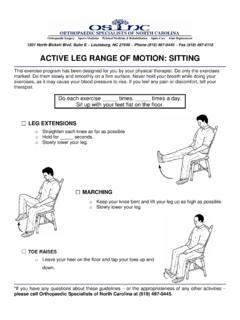Transcription of STRATEGIES TO INCORPORATE ACTIVE LEARNING …
1 STRATEGIES TO INCORPORATE ACTIVE LEARNING INTO ONLINE. TEACHING. Diane Austin, , Instructor and Distance LEARNING Technology Specialist*. Nadine D. Mescia, , Director of Training . What is ACTIVE LEARNING ? Bonwell and Eison describe ACTIVE LEARNING STRATEGIES as those that involve students in doing things and (have the students). think about the things they are doing (Bonwell and Eison, 1991, p. iii). ACTIVE LEARNING is a key element in the LEARNING process and most adult LEARNING models view interaction ( ACTIVE LEARNING ) as a crucial component (Mantyla, 1999, p. 19). In an effective LEARNING environment that incorporates ACTIVE LEARNING STRATEGIES , greater emphasis is placed on students exploration of their own meaning, attitudes, and values (Bonwell and Eison, 1992; Mantyla, 1999, ).
2 However, a mistaken view many educators have is that LEARNING is an ACTIVE process and as such, all LEARNING is ACTIVE , even the most commonly used form of instruction, the passive lecture. In an ACTIVE LEARNING environment, less emphasis is placed on transmitting information (teacher-centered) and more on developing students'. skills (student-centered) (Bonwell and Eison, 1991, ). ACTIVE LEARNING is not only an effective instructional strategy in the traditional LEARNING environment, but also, it is effective in an online environment. Instructors/designers must continue to design activities that support LEARNING objectives, but structure them to work online, outside of the traditional classroom environment where ACTIVE LEARNING techniques are heavily dependent upon face- to-face interaction ( , discussion, group work, role-play).
3 For example, consideration must be given to the fact that instructor and learners may not be in the same place at the same time (asynchronous) to interact whereby relying on instructional technologies as part of the interactive LEARNING process. However, the online environment can sometimes be a more favorable LEARNING environment for students in that all have equal opportunity to participate, share thoughts and develop ideas over periods of time. Students' expressions are not limited by the class size, which are called upon, or time allotted to participate (Harasim, et al, 1997). Why ACTIVE LEARNING ? Succinctly stated, ACTIVE participation strengthens LEARNING regardless of environment (Harasim, et al, 1997, p.)
4 29). ACTIVE LEARNING requires intellectual effort, encouraging higher-order thinking (analysis, synthesis, evaluation) and provides a means for the learner to assimilate, apply, and retain LEARNING (Bonwell and Eison, 1991; Harasim, et al, 1997). STRATEGIES promoting ACTIVE LEARNING are superior to passive LEARNING (lectures) in promoting the development of student's skills in thinking and writing (Bonwell and Eison, 1991, iii). ACTIVE LEARNING accommodates a variety of LEARNING styles, promotes student achievement, enhances learner motivation, changes student attitudes, and basically, causes learners to learn more (Astin, 1985). Bonwell and Eison contend that from a preference perspective, students (generally) prefer STRATEGIES promoting ACTIVE LEARNING to traditional lectures and other passive methodologies (1991).
5 * School of Library and Information Science, University of South Florida Florida Center for Leadership in Public Health Practice, COPH, University of South Florida ACTIVE LEARNING empowers students to take primary responsibility for their education (student-centered) (Warren, 1996), although requiring faculty to relinquish some control to the student to encour age their LEARNING path (Gibson, 1998, ). What are appropriate ACTIVE LEARNING STRATEGIES for an online environment? Designing instructional STRATEGIES (traditional or online) to engage learners is challenging. Traditional STRATEGIES must be adapted and/or new STRATEGIES developed for the online LEARNING environment. Widely used effective ACTIVE LEARNING STRATEGIES such as group work or role-play can even be successfully adapted for an online environment.
6 When developing ACTIVE LEARNING STRATEGIES for an online environment, the instructor/designer should first consider sound design practices including, but not limited to: assessing the learners, knowing the context and environment in which learners will be operating, knowing instructional tools and techniques for delivery, developing supporting STRATEGIES in the form of directions and resources, incorporating assessment of LEARNING outcomes and course design, and designing with ACTIVE engagement in mind (Mantyla, 1999). Starting from a basic instructional design model and continuing good teaching practices are important because according to Moore and Kearsley, ACTIVE LEARNING is probably not going to happen in an online environment unless the interaction is deliberately planned and the instructor encourages it (1999).
7 Components of good ACTIVE LEARNING activities are the same, whether presented in traditional or in online environments. Activities should 1) have a definite beginning and ending; 2) have a clear purpose or objective; 3) contain complete and understandable directions; 4) have a feedback mechanism; and 5). and include a description of the technology or tool being used in the exercise (Mantyla, 1999, ). When using traditional ACTIVE LEARNING STRATEGIES , instructors/designers will want to consider the following: Can learners complete the activity independently? Will they need specific guidance before or during the activity? Will visuals or other materials be needed? Will they need to collaborate with other learners?
8 How do the learners ask questions? Will there be formative or summative evaluation? What tools will be available to support the activity, including technology, resources, and examples? Should different STRATEGIES and tools that provide multiple ways of experiencing LEARNING ? (Mantyla, 1999, p. 65) There are many examples of ACTIVE LEARNING STRATEGIES that can be adapted for the on- line classroom including, but not limited to: Assessment - tests and Readings, case Discussions (virtual quizzes that provide studies chat, bulletin board). immediate feedback Writings (reflective Projects- group Experiential LEARNING : journals, summaries, or individual Internships/Preceptor- essays, critiques) ships/ Externships Demonstrations with Study/support Visual-based questioning (video clips) groups instruction (streamed video or CD).
9 Games & Simulations Problem solving Online Presentations Community building Role-play Directed research In summary, ACTIVE LEARNING STRATEGIES are effective in engaging learners and assisting them in creating their own LEARNING experiences. Models and tested STRATEGIES can help instructors/designers (novice and experienced) develop new activities to engage learners in the online environment. It is the instructor's (designer's) responsibility to develop an environment that supports ACTIVE LEARNING STRATEGIES and methods to enhance LEARNING and support the LEARNING objectives. There are many resources available to support developing effective online LEARNING environments through ACTIVE LEARNING STRATEGIES .
10 For an annotated list and a copy of this presentation, visit BIBLIOGRAPHY. Astin, A. W. (1985). Achieving educational excellence. San Francisco: Jossey- Bass. Barron, A. E. & Ivers, K. S. (1998). The internet and instruction: Activities and nd ideas (2 ed.). Englewood, CO. Libraries Unlimited, Inc. Bonwell, C. C., & Eison, J. A. (1991). ACTIVE LEARNING : Creating excitement in the classroom. Washington, DC: ASHE-ERIC Higher Education Report No. 1. Brooks, D. W. (1997). Web-teaching: A guide to designing interactive teaching for the world wide web. New York, NY: Plenum Press. Canady, R. Rettig, M. D. (1996). Teaching in the block: STRATEGIES for engagin g ACTIVE learners. Larchmont, NY: Eye on Education. Fogarty, R.







